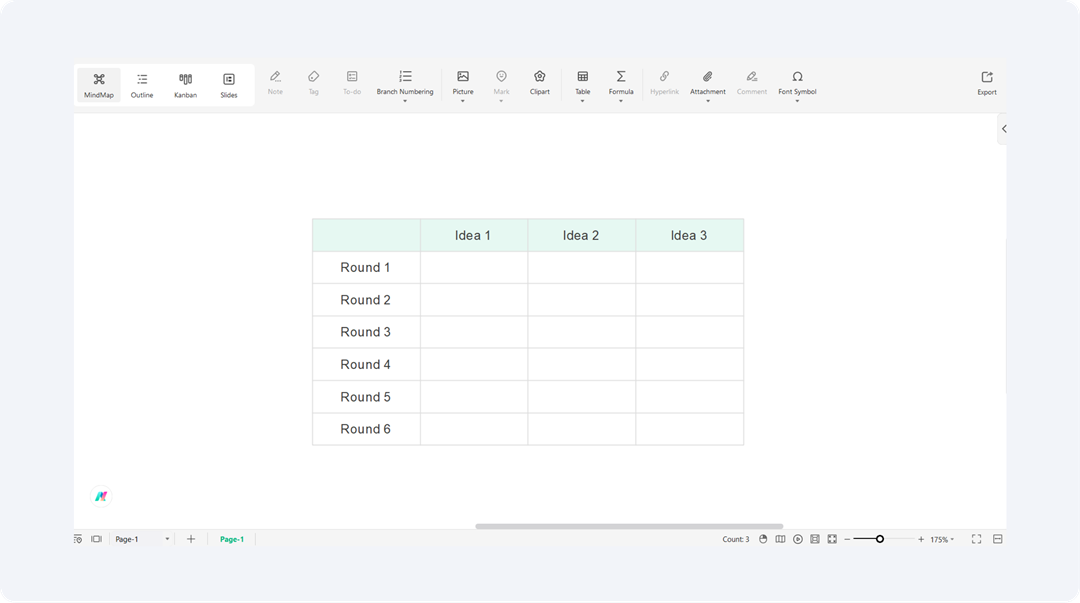Recently, during the work on a product development sprint, my team reached a point of silence. The sticky notes were empty, the coffee was cold, and the ideas were stalled. Someone joked about rearranging the process: "Let's attempt to pass along ideas instead of shouting them out." After thirty minutes, we sketched 108 actionable ideas. The catalyst? 6-3-5 brainwriting.
In this article
It is a structured method of turning silent collaboration into speedy innovation. This technique has been overshadowed by conventional brainstorming. It uses written communication to beat groupthink and foster varied ideas. In this article, I will describe the 6-3-5 brainwriting method. Moreover, it includes its step-by-step procedure, why it excels under time pressures, and its drawbacks.
What is 6-3-5 Brainwriting?

The 6-3-5 brainwriting method is a structured method of coming up with a large number of ideas within a limited amount of time. It involves six members, and each of them writes down three ideas. They do this in five minutes. The sheets of ideas are passed around the group so that every member can build upon other people's ideas.
It was developed as an alternative to traditional brainstorming. This solves issues like groupthink and unequal participation. In six rounds, the team generates 108 ideas. This produces creative solutions. The process guarantees that everyone contributes equally. Moreover, it takes advantage of the group's collective creativity.
Now that you know what 6-3-5 brainwriting is, let's talk about how to use this method with your team effectively.
Benefits of 6-3-5 Brainwriting
Knowing how 6-3-5 brainwriting works is a good beginning, but its usefulness is in its benefits. We will outline five main advantages to this technique below. These are the reasons why it is a successful technique for improving teamwork in groups.
Equal Participation
In conventional brainstorming, loud mouths take over, and softer-spoken members struggle to be heard. In 6-3-5 brainwriting, every individual contributes three ideas per round. It guarantees that all six team members have an equal contribution. It overcomes obstacles like shyness or rank, and anyone can participate. The result is greater ideas from everyone on the team.
Less Groupthink
Groupthink hampers creativity when members follow the crowd. Silent and individual idea writing comes first in 6-3-5 brainwriting. This reduces pressure to agree with others early on. Members do not build ideas upon each other until later. This setup encourages innovative, individual ideas and discourages conformity.
Generating Ideas Effectively
Time is of the essence in brainstorming. The 6-3-5 method is quick and orderly. Six participants can come up with 108 ideas in six rounds of five minutes each. The pace maintains the energy level and prevents over-thinking. It's ideal for groups that need many ideas within a limited amount of time.
Greater Creativity Through Collaboration
This method integrates individual and collective imagination. Each person begins with his or her own suggestions. Subsequently, through the exchange of papers, they add to someone else's ideas. New ideas and linkages are created in this process. Ideas develop and become better as they are crafted by the group. This results in creative solutions.
Clear Documentation
6-3-5 brainwriting differs from talking out ideas. During the session, all members record their ideas on sheets. This provides a clear record right away. No ideas get lost, and there is no need for extra notes. Teams can go through the ideas afterward and pick the best ones.
Drawbacks of 6-3-5 Brainwriting

6-3-5 brainwriting is not all good; it also has some drawbacks. Let us now look at its drawbacks. Being aware of them will enable you to use the technique and address any problems that might crop up.
Rigidity of Structure
The method demands six individuals be used, three concepts per person, and five-minute increments. Rigid design can compromise flexibility. Team members used to brainstorming can feel shackled. It prevents tailoring the process to individual requirements.
Time Pressure
Each round takes just five minutes. This very limited time can make slow thinkers feel pressured. Having to hastily write down three ideas can lead to bad or half-cooked thoughts. Creativity can be stifled under pressure.
Fixed Group Size
It takes exactly six people. If you have more or fewer in your group, you will have to modify the method. This can throw off the balance of idea generation. Smaller or larger groups might have a hard time following the format.
Lack of On-the-Spot Discussion
The process is quiet, and there is no chance to speak. Individuals are not able to discuss or describe concepts spontaneously. This can lead to confusion or missed opportunities to build on concepts. Concepts can be unclear without immediate feedback.
Risk of Decreased Idea Quality
The goal is 108 ideas rapid-fire. Quantity can sacrifice quality. There are going to be lots of repeating or superficial ideas. Teams might spend more time afterward to sort out the best ones.
How to Use the 6-3-5 Brainwriting Method?
Now that we've covered 6-3-5 brainwriting, let's move to the subsequent steps. We are going to use EdrawMind to design a fine rubric for this method. The software helps keep your ideas clear and well-organized. This makes it simple for your team to navigate the process of 6-3-5 brainwriting easily, thus making it effective and simple to understand.

Step 1Gather the team and lay out the facts
- Gather six individuals. State the problem or topic that you want ideas on. Make sure all are aware of the goal.
- Give each person a worksheet or large piece of paper to write on. This setup is needed for the process to work successfully. It gets the team ready for structured brainstorming.
Step 2Start the timer and begin round one
- Set a timer for five minutes to keep them moving. Each person is working alone and putting down three ideas on their paper.
- Everyone should be free and creative in their thinking. Instruct everyone to be quiet—no discussion yet. This is all about creating ideas on your own to get the process started.
Step 3Pass the Worksheets
- After five minutes, ask each person to pass his or her worksheet to the person on their left. You can pass to the right if you prefer, just keep it one direction.
- This step brings in collaboration. It lets ideas circulate around the group so others can build on them in the next rounds.
Step 4Place ideas in later rounds
- Set the timer to five minutes again. Every participant writes down three new ideas on the worksheet they have. They may build on what is already there or create additional ones.
- Rotate the worksheets to the next participant after each round. Do this for a total of six rounds. This way, everyone adds to every sheet.
Step 5Collect and Review the Ideas
- After six rounds, gather all worksheets. There should be 18 ideas on each sheet, six rounds multiplied by three ideas. The group looks them over together.
- Talk about what are the most interesting ideas. Look for patterns or good ideas. Choose the best ideas to elaborate on or to carry out immediately.
Brainwriting vs Brainstorming
In order to see the differences between brainwriting and traditional brainstorming, we will contrast them in a table. This exact comparison will allow you to choose the best method for your team.
| Aspect | Brainstorming | Brainwriting |
| When to use | For quick, broad ideas; suits relaxed groups; best face-to-face | To include all voices; for sensitive issues; avoids groupthink; works in virtual settings |
| Participation style | Verbal, interactive, and spontaneous | Written, individual, then shared |
| Idea generation approach | Collective, built in real-time | Individual first, then collective via sharing |
| Time efficiency | Fast but may need extra time to discuss | Structured and efficient in output but slower overall |
| Group size suitability | Best for small to medium groups | Flexible, adaptable to various sizes |
| Output format | List of ideas, often needs later organizing | Written ideas, easy to collect and share |
| Facilitation requirements | Needs a skilled facilitator to guide discussion | Requires clear instructions, less guidance during writing |
Final Remarks
When a team brainstorming session stalls in silence, a structured spark can relight the fire of innovation. The article tracks a team's shift to 6-3-5 brainwriting to lead to 108 ideas in thirty minutes—a sign of its success. The method transforms silent collaboration into innovation. It outshines traditional brainstorming in giving each person an equal say. It prevents groupthink.
Yet, its strict format and time limit can be daunting to some, and not being allowed to talk right away may obscure ideas. However, the 6-3-5 brainwriting method allows teams to tap into their creativity with the help of tools like EdrawMind. We've also mentioned the step-by-step process so you don't get lost.
Get the worksheets ready, start the timer, and allow the silence to work wonders now!




